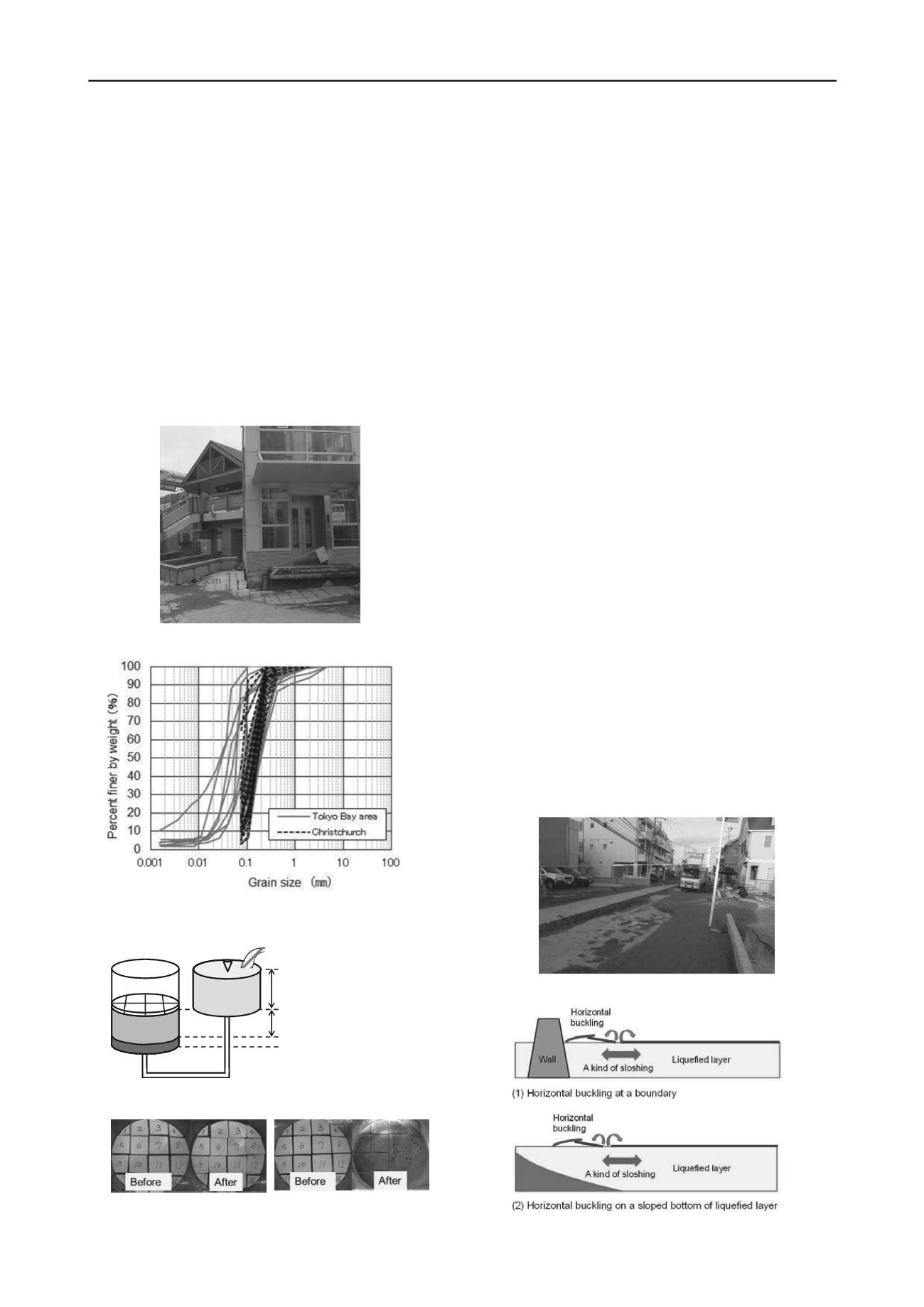
1661
Technical Committee 203 /
Comité technique 203
P
L
for all boring data under the assumption of
C
w
=0.82 and
C
w
=1.0. If
C
w=0.82,
P
L
for liquefied sites are calculated to be
greater than about 10 and the severity of liquefaction can be
demonstrated.
3 PLENTY OF BOILED SAND AND LARGE
SETTLEMENT
Much eruption of sands and large ground subsidence occurred
in the liquefied area. The maximum thickness of the erupted
sand and the maximum ground subsidence observed by the
author were about 30 cm and 50 cm, respectively, as shown in
Figure 8. This was the first time the author had seen such
thickly deposited boiled sand in Japan. However, much eruption
and large subsidence also occurred in Christchurch, New
Zealand during the main shock in September 2010 and the
aftershock in February 2011. Erupted sands in Christchurch and
Tokyo Bay were silty sands or sandy silts with much fines, as
shown in Figures 9. A model test was carried out to demonstrate
how very fine sandy soils cause much eruption and large ground
subsidence.
Two sets of testing devices, schematically shown in Figure
10, were prepared, one for a silty sand erupted in Urayasu and
the other for a clean sand named Toyoura sand which had no
fines. Water tanks and acrylic cylinders 30 cm in diameter were
connected with pipes. Testing soils were filled in the acrylic
cylinders to a thickness of
L
=10 cm, then concrete blocks,
which were models for road pavement, were placed on the
surfaces of the soils. Water was flowed from the water tanks to
the soils for three minutes to heights of
H
=10 cm, 12.5 cm, 15
cm or 17cm. Figure 11 (a) shows the surface of the model
pavement before (left) and after (right) the water flow for
Toyoura sand with the hydraulic gradient
H
/
L
=1.5. Only a few
soil particles erupted onto the pavement even though water had
passed through the soil and stood on the pavement. On the
contrary, for Urayasu sand, many soil particles erupted onto the
pavement, as shown in Figure 11 (b). The deposited Urayasu
sand was about 3 cm thick.
It is estimated that fine soil particles were easily lifted
above the ground surface by the ejecting water and that the
removal of the deposited soils by inhabitants accelerated the
settlement of the ground surface. Moreover, from the very fine
sandy soils, water was ejected for a long time because of the
low permeability of these soils.
4 A KIND OF SLOSHING OF LIQUEFIED GROUND AND
ITS EFFECT ON ROAD AND BURIED STRUCTURES
Strange heaving, buckling or thrust was observed at several
footways and alleys, as shown in Figure 12. Some boundaries
existed besides the footways and alleys, such as banks of old sea
walls and elevated bridges. Therefore, some thrust might have
occurred at these boundaries due to a kind of sloshing of
liquefied ground, as schematically shown in Figure 13 (1),
because shaking continued for long time after the occurrence of
liquefaction, as mentioned above. On the other hand, the
heaving of a footway was observed even though there was no
such boundary as shown in Figure 12. The locations of heaved
footways and alleys in Urayasu City, with and without
Figure 8. Large settlement induced at Shin-urayasu station
Figure 11. Surface of the model pavement before and after the water
flow
(a) Toyoura sand
(b) Urayasu sand
Figure 9. Grain size distribution curves of boiled sands in Tokyo
Bay area and Christchurch
Figure 10. Testing device for eruption of sand
Tank
Model ground
Pour wat er
Wat er head
di f f erence: h
Thi ckness
L=100mm
Gravel =50mm
Figure 12. Thrust of an alley in Urayasu City
Figure 13 Two possible mechanisms of thrust or heaving


